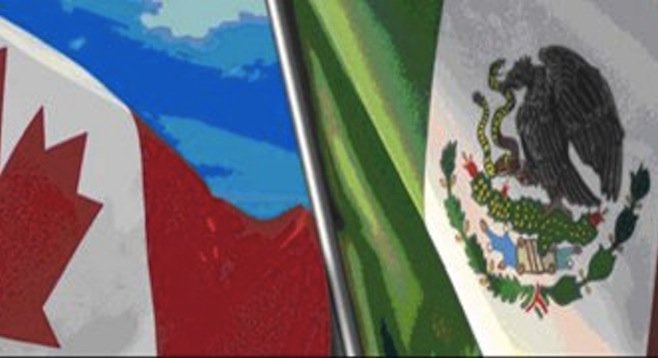 Facebook
Facebook
 X
X
 Instagram
Instagram
 TikTok
TikTok
 Youtube
Youtube

Canada has joined the United States in warning its citizens of the potential dangers they may face when visiting Mexico, with specific reference to Baja California.
In an advisory posted on the home page of the Canadian embassy in Mexico City, Canadians are counseled to "exercise extreme caution" when traveling in Baja California.
The Canadian advisory also suggests the same level of prudence for travel to Morelos, Nayarit, Jalisco, San Luis Potosí, Veracruz and Zacatecas because of "high levels of organized crime in rural areas, including on major highways."
"There is no nationwide advisory in effect for Mexico," reads the advisory, first issued in December and updated on January 22. "However, you should exercise a high degree of caution, especially in those parts of the country experiencing a deteriorating security situation. Most major tourist areas have not been affected by the extreme levels of violence in the northern region.
"The Yucatan Peninsula, which includes the tourist destinations of Cancun, Cozumel, Riviera Maya, Merida and Progreso, has not been significantly affected by violence or insecurity," the advisory continues.
"We strongly recommend travel to Mexico by air in order to avoid land border crossings through potentially dangerous regions," reads the advisory.
"The coastal areas of Jalisco (from Puerto Vallarta to Barra de Navidad) and southern Nayarit (from Nuevo Vallarta to La Peñita de Jaltemba), popular destinations among Canadians, remain relatively safe, as do the Lake Chapala area and the cities of Cuernavaca, Tepotzlan, Guadalajara, San Luis Potosi, Xalapa, Veracruz, and Zacatecas. When travelling in these regions, exercise extreme caution when venturing outside urban areas."
The Canadian advisory echoes a warning reissued by the U.S. State Department on January 9 (the previous advisory was issued on July 12, 2013): "Exercise caution in the northern state of Baja California, particularly at night," reads the U.S. advisory. "There were 458 homicides in Tijuana from October 2012 through September 2013, compared with 324 for the same period a year earlier. Murders in Mexicali declined in the same period from 166 to 132. In the majority of these cases, the killings appeared to be targeted TCO (Transnational Criminal Organizations) assassinations. Turf battles between criminal groups resulted in assassinations in areas of Tijuana and Mexicali frequented by U.S. citizens. Shooting incidents, in which innocent bystanders have been injured, have occurred during daylight hours."
The latest U.S. warning drew a quick response from Baja's governor, Francisco Vega de Lamadrid. "Baja California continues to be a safe state to visit, continues to be an example among border states, continues to be a state that offers a lot — and what Baja California offers more than anything else is quality attention from Baja Californians," the governor was quoted as saying in a January 12 interview in the daily newspaper El Sol de Tijuana.


Canada has joined the United States in warning its citizens of the potential dangers they may face when visiting Mexico, with specific reference to Baja California.
In an advisory posted on the home page of the Canadian embassy in Mexico City, Canadians are counseled to "exercise extreme caution" when traveling in Baja California.
The Canadian advisory also suggests the same level of prudence for travel to Morelos, Nayarit, Jalisco, San Luis Potosí, Veracruz and Zacatecas because of "high levels of organized crime in rural areas, including on major highways."
"There is no nationwide advisory in effect for Mexico," reads the advisory, first issued in December and updated on January 22. "However, you should exercise a high degree of caution, especially in those parts of the country experiencing a deteriorating security situation. Most major tourist areas have not been affected by the extreme levels of violence in the northern region.
"The Yucatan Peninsula, which includes the tourist destinations of Cancun, Cozumel, Riviera Maya, Merida and Progreso, has not been significantly affected by violence or insecurity," the advisory continues.
"We strongly recommend travel to Mexico by air in order to avoid land border crossings through potentially dangerous regions," reads the advisory.
"The coastal areas of Jalisco (from Puerto Vallarta to Barra de Navidad) and southern Nayarit (from Nuevo Vallarta to La Peñita de Jaltemba), popular destinations among Canadians, remain relatively safe, as do the Lake Chapala area and the cities of Cuernavaca, Tepotzlan, Guadalajara, San Luis Potosi, Xalapa, Veracruz, and Zacatecas. When travelling in these regions, exercise extreme caution when venturing outside urban areas."
The Canadian advisory echoes a warning reissued by the U.S. State Department on January 9 (the previous advisory was issued on July 12, 2013): "Exercise caution in the northern state of Baja California, particularly at night," reads the U.S. advisory. "There were 458 homicides in Tijuana from October 2012 through September 2013, compared with 324 for the same period a year earlier. Murders in Mexicali declined in the same period from 166 to 132. In the majority of these cases, the killings appeared to be targeted TCO (Transnational Criminal Organizations) assassinations. Turf battles between criminal groups resulted in assassinations in areas of Tijuana and Mexicali frequented by U.S. citizens. Shooting incidents, in which innocent bystanders have been injured, have occurred during daylight hours."
The latest U.S. warning drew a quick response from Baja's governor, Francisco Vega de Lamadrid. "Baja California continues to be a safe state to visit, continues to be an example among border states, continues to be a state that offers a lot — and what Baja California offers more than anything else is quality attention from Baja Californians," the governor was quoted as saying in a January 12 interview in the daily newspaper El Sol de Tijuana.
Comments